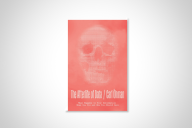You have /5 articles left.
Sign up for a free account or log in.
It was a classic instance of blaming the messenger: Spanish newspapers carried the earliest reports of a new illness that spread across the globe in the final months of World War I, and so it be came known as “Spanish influenza,” although its real point of origin will never be known. It was virulent and highly communicable. A paper appearing in the Centers for Disease Control and Prevention journal Emerging Infectious Diseases a few years ago estimated that 500 million people, almost a third of the world’s population, were stricken with it. By the end of its reign of terror in the final months of 1920, there were 50 million fatalities -- more than three times as many as died from the war itself. These figures may be on the low side.
In her two long essays on illness, Susan Sontag grappled with the strong and longstanding tendency to treat certain diseases as meaningful: the vehicle for metaphors of social or cultural disturbance. “Feelings about evil are projected onto a disease,” she wrote. “And the disease (so enriched with meanings) is projected onto the world." Just so, one would imagine, with a pandemic. Something in a plague always hints at apocalypse.
But the striking thing about Spanish influenza is how little meaning stuck to it. Plenty of sermons must have figured the Spanish flu as one of the Four Horsemen, at the time, but the whole experience was quickly erased from collective memory, at least in the United States. In 1976, the historian Alfred W. Crosby published a monograph called Epidemic and Peace: 1918 that Cambridge University Press later issued as America’s Forgotten Pandemic (1989). Apart from being snappier, the new title underscored the almost total disappearance from anything but the specialist’s sense of history. One person in four in the U.S. suffered from an attack of Spanish flu, and it killed some 675,000 of them. The catastrophe seems never to have interested Hollywood, though, and the only work of fiction by an author who lived through the outbreak, so far as I know, is Katherine Anne Porter’s novella “Pale Horse, Pale Rider.” (Biblical imagery seems just about unavoidable.) (Note: This article was updated from an earlier version to correct the name of the author of Epidemic and Peace: 1918.)
The title of Nancy K. Bristow’s American Pandemic: The Lost Worlds of the 1918 Influenza Epidemic (Oxford University Press) is an echo of Cross’s America’s Forgotten Pandemic. I don’t want to read too much into the one-word difference, but it does seem that the influenza crisis of almost a century ago has been working its way back into public awareness in recent years. Several more books on the subject have appeared since Gina Kolata’s best-seller Flu: The Story of the Great Influenza Pandemic of 1918 and the Search for the Virus That Caused It came out in 1999. The Public Broadcasting Service has done its part with an excellent documentary as well as an episode of Downton Abbey in which pestilence hits a country house in England during a dinner party.
So “forgotten” is no longer quite the right word for the nightmare. But it remains almost impossible to imagine the ferocity of the pandemic, much less its scale. The contemporary accounts that Bristow draws on retain their horror. Doctors wrote of patients changing from “an apparently well condition to almost prostration within one or two hours,” with raging fevers and severe pain in even the milder cases – and the worst involving a “bloody exudate” coughed up from the “peculiar and intense congestion of the lungs with [a] hemorrhage,” so that it was “simply a struggle for air until they suffocate.”
Morgues were overrun. In poor households, several delirious family members might be crowded into the same bed along with someone who had died. Those who made it to the hospital could lie unattended for days at a time. The authorities were issuing “don’t worry, it’s just another flu”-type pronouncements well into the catastrophic phase of the epidemic. Quarantines and bans on public gatherings were easier to proclaim than to enforce. Having absorbed the relatively new idea that disease was spread by germs, people donned surgical masks to protect themselves – to no avail, since influenza was a virus. The epidemic went through three waves of contagion in as many years, and it wore down whatever patience or civic-mindedness people had when the disaster hit.
A pandemic, by definition, puts everyone at risk. But access to medical help – inadequate as it proved – was far less egalitarian. (As is still the case, of course.) Much of the historical scholarship on disease in recent decades has stressed how the interaction between medical professionals and their clientele tends to reinforce the social hierarchies already in place. Bristow’s work follows this well-established course, combining it with a familiar emphasis on the changes in medicine’s public role in the wake of Progressive Era reforms.
She writes about how poor, immigrant, or Native American sufferers were assumed guilty “of dishonesty and laziness, and of attempting to take advantage of others’ generosity” until proven otherwise, while the African-American population was forced “to continue relying on their own too limited community resources as they sought to provide sufficient care for their sick neighbors.” And while the U.S. Public Health Service had been created in 1912, its capacity to respond to the influenza crisis was limited, given how poorly the disease was understood. Even gathering reliable statistics on it proved almost impossible while the virus was on its rampage.
The most interesting chapter of America’s Pandemic considers how doctors and nurses responded to the crisis. Although they often worked side-by-side together, their experiences were a marked contrast.
“Ignorant of the disease’s etiology, uncertain of the best methods of treatment, and unable to ease the suffering of their patients,” Bristow writes, “physicians often expressed a sense of helplessness as individuals and humility as members of a profession.” (You know something is catastrophic when it reduces doctors to humility.)
Belonging to an almost entirely male profession, they “gauged their work against the masculine standards of skill and expertise” – and the inevitable military metaphor of going to battle against the disease became that much more intense given the example of actual soldiers fighting and dying in the trenches. But the influenza virus was stronger. “Like a hideous monster,” one physician wrote, “he went his way, and none could hinder.” Doctors’ letters and diaries from the period reflect a sense of bewilderment and failure.
For a while the authority of the profession itself was undermined. Patent medicines and related quackery proved no more effective in treating or preventing the disease than anything the doctors could offer. But they weren’t any less effective, either.
The nurses could not have responded more differently. Caring for patients was “a terrific test” and “high privilege,” they wrote, “a most horrible and yet most beautiful experience.” As with doctors, many lost their lives while tending to the sick. But one nurses’ report said that the work was “one of the most immediately satisfactory experiences of our lives” for those who survived it, “and this is true even though we were borne down with the knowledge that, do all we might, the pressing, tragic need for nursing was much greater than could possibly be met.”
And this, too, was a matter of gauging their skill by socially sanctioned gender norms. “Women working as nurses aspired to what they viewed as the uniquely feminine qualities of domesticity, compassion, and selflessness,” writes Bristow. “To measure up to these standards nurses needed only to care for their patients, not cure them, and this they proved able to do.”
A few hours after choosing American Pandemic for this week’s column, I attended a public event at which every third person seemed to be coughing, with a congested wheeze usually audible. Synchronicity is not always your friend. For the past several days I have been reading about influenza, and writing about it, while suffering from one of its milder variants. The experience is not to be recommended.
Two quick points might be worth making before the medication kicks in. Bristow’s final assessment is that the horror and devastation of the pandemic could not be reconciled with the preferred national narrative of progress and redemption, “with its upbeat tenor and its focus on a bright future.” At most, its memory was preserved as part of local history, or through family stories.
The argument is plausible, to a degree, but it overlooks the element of trauma involved – not just the suffering and death during that period, but the feeling of being rendered helpless by an event that’s come out of nowhere.
And what sense does it make to think of the events of 1918-20 as “America’s pandemic,” forgotten or otherwise? Deaths from influenza in the United States during that period represent something like 1.4 percent of the world’s fatalities from the disease. How was it remembered -- or erased from public memory -- elsewhere? Diseases don’t respect borders, and it’s hard to see why the historiography of disease should, either.








